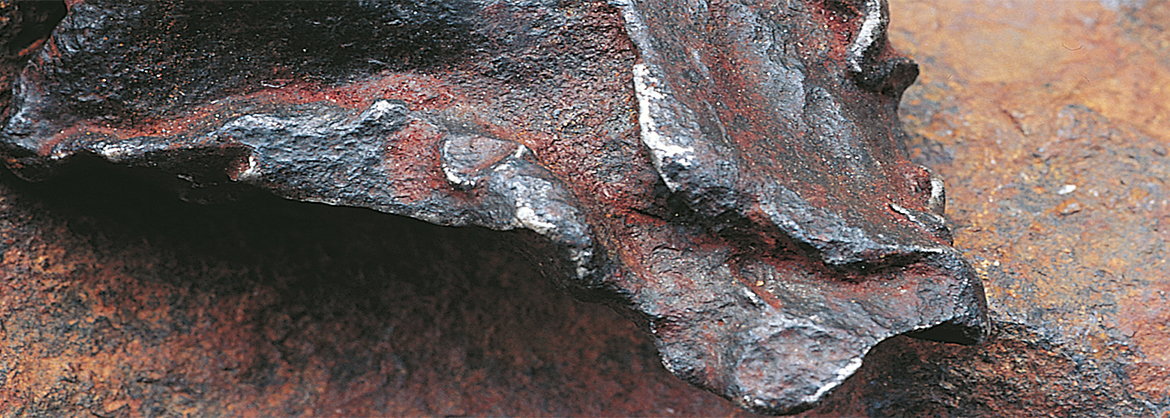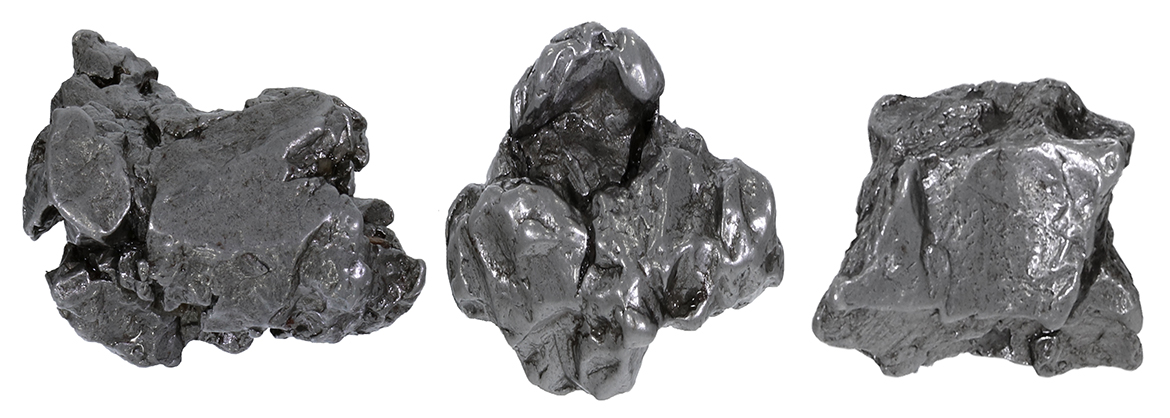
Meteorites - Meaning and Effect
Meteorites helps to critically scrutinize one's own intentions, plans and goals. New perspectives can be adopted, previously unknown aspects can be carefully examined and outdated structures can be overcome. Many things are put to the test in order to initiate the necessary changes. Meteorites are also valuable helpers here, strengthening the implementation of spontaneous impulses into energetic action.
Meteorite: origin of the name
The name Meteorite comes either from the Greek "meteoron", which translates "celestial phenomenon" or from the Ancient Greek "meteoros" ("lifted up", "high in the air"). Synonyms for this stone until the 20th century was meteorite, before that aerolite or sky stone was also common. Since the Meteorites come from the solar system, these are unique witnesses of the origin of our solar system and mostly older than our earth. They make thus valuable views possible into its early time and have therefore a very high value for the study of our planets.
According to the modern classification meteorites are counted to the rocks, independently of their chemical composition. A distinction is made here between meteoroid and meteorite. Meteoroids burn up either completely with the entrance into the earth atmosphere with an accompanying luminous appearance, which begins approximately in a height of 100 km (meteor), or go down on the ground. Arrived on earth they are then called meterorites.

As interplanetary fragments, they originate either from asteroids (small planets) from the asteroid belt between Mars and Jupiter or from comets, which from the borders of our solar system occasionally come close to Earth. Even more rarely, it is debris from the Moon or Mars that is blown off by asteroid impacts. If these reach now to the earth, thereby speeds of over 70 km per second or 260,000 km/h are quite possible and this "cosmic debris" is heated up by the atmosphere of the earth (friction heat). So typical melting phenomena are formed on the surface of the invaders. Their composition consists either of stones or iron and a mix of both Findings. Therefore, these interplanetary rocks are roughly divided into iron meteorites (also named as celestial iron or meteoric iron), stony iron meteorites or stony meteorites.
Meteorites for resale can be found here in our webshop
Classification of meteorites
Meteorites are classified according to, in addition to chemical and petrological classification:
- weathering classes, that is, the degree of weathering since their impact on the earth's surface, which is shown either in the transformation of metals into oxides as well as silicates into clay minerals in One side polished pieces or in the strength of the brown coloration by iron oxides visible on fracture surfaces
- shock classes when knocking loose from the parent body, which can result in a kind of metamorphism or fracture structures (small cracks)
- three different ages: the age of origin, irradiation age and terrestrial age
- the internal structure of the finds:
a. undifferentiated, non-shelled structure: chondrites
b. differentiated structure: these celestial bodies show mostly a shelled structure like the earth and originate as a consequence predominantly from asteroids. A further subdivision is made after the area of the asteroid, from which the fragment comes: achondrites (mantle), iron meteorite (core) and stony iron meteorite (transition area between core and mantle)

Widmannstätten figures - unique in meteorites
Cut and etched with nitric acid a lamellar cubic structure from different alloys becomes visible with pure iron meteorites, the so-called Widmannstätten figures. This lattice structure with crossing planes reflects imposingly the heterogeneous structure, which terrestrial iron does not show, because this structure can only develop, if a molten metallic body cools down very slowly, over millions of years. Since such cooling times are reached only in the core of celestial bodies, a find with this structure can thus be clearly identified as a meteorite. However, there are iron meteorites which do not show Widmanstätten figures; their absence does not necessarily exclude a meteorite. Also as a further criterion a nickel content of at least 4% can serve as evidence for an iron meteorite. Depending on the nickel content three alloys are distinguished: Kamazite, Taenite and Plessite. Cobalt and Copper could be likewise proven as further elements.
Stone meteorites contain silicate minerals, which are also known on earth, e.g. Diopside, Bronzite, Serphene, Enstatite, Orthoclase, Hypersthene, Peridote, Plagioclase, Magnetite and Diamond. If these silicates are embedded as millimeter- to pea-sized grains (Greek chondros = grain) in a subordinate nickel-iron matrix, they are called chondrites. Chondrites represent approx. 93% of all stone meteorites and contain the first and thus oldest chemical and at the same time heavy elements, which developed in the solar system by nuclear fusion. Besides one finds in them small metallic iron particles which are magnetic; a test with a magnet can be carried out therefore very easily as a proof for a cosmic origin of the Chondrites. The relatively seen rather rare Achondrites on the other hand possess a basalt-like, to a large extent nickel-iron-free structure without grains and a usually shining-black fusion crust.
If the nickel iron content is a main component, besides intercalated minerals like Peridote, Pyroxene and Plagioclase, Meteorites are called stony iron meteorites . A well-known representative of this group is the Pallasite, which contains beside nickel iron mainly Peridote. Thus Pallasite represents at the same time the Urmaterie of our earth, because our homeland planet consists for the most part of a nickel iron core and the peridot-leading earth mantle.

Meteorites for resale can be found here in our webshop
Typical for all Meteorites is a pebble-round or cinder-like appearance. Stone meteorites have charcoal-black, brown or blasted hues. If iron is present, they tend to show colors similar to other iron minerals, i.e. iron-gray to rust-brown hues, and depending on the iron content, the typical metallic luster. Pseudometeorites have great similarity with the extraterrestrial witnesses, but are then unmasked due to their composition clearly as terrestrial origin.
The largest part of the shooting stars, which reach our planet, burn up during the entrance into the atmosphere. Only in rare cases do fragments reach the Earth's surface. Of these, most Meteorites fall into the oceans, which make up most of the surface on Earth. All others reach the land surfaces and there mostly uninhabited area, thus remain undiscovered. The then still vanishingly small portion is found and can be documented finally. To make matters worse, this cosmic material must visually stand out from the surrounding rock at the site where it is found in order to be noticed, and it weathers easily due to the oxidation of the metallic iron, which is not stable on the Earth's surface. Decay in our temperate climates progresses faster than in arid regions (deserts), where water is lacking, or ice regions (Antarctica), which freeze the finds. Due to better preservation, they can accumulate over thousands of years, are protected from the weather by new sediment layers and are preserved for long periods of time. By later recent weathering processes (thawing of the glaciers, wind erosion in hot deserts) again released one finds then regular meteorite fields ("meteorite traps"). Therefore many factors play a role, if a Meteorite survives at all and in consequence can be found at all. Therefore Meteorites are very rare and valuable.
The witnesses from the universe occur world-wide. The most important occurrences are in Namibia, Ukraine, Mexico, Chile, USA, Russia, China, Australia and Argentina. Found pieces are usually named after their place of discovery (place, river etc.). The world's largest meteorite, an iron meteorite called Hoba, weighs 60 tons and was found in Namibia in 1920. The meteorite Nogata from the year 861 A.D. is the earliest worldwide observed case of which material is still preserved today, but in Europe the meteorite of Elbogen in Bohemia from 1400 A.D. Extensively weathered meteorites, which can only be recognized by their structure, can be found e. g. in Sweden from the Ordovsko meteorite.
It can be also that the earth atmosphere brakes v.a. smaller Meteorites in such a way that they simply fall in the free fall to the ground or are blown apart explosively. Studies have shown that there were on average about five such observed meteorite falls per year in the years 1970 to 2009. In fact, however, there are many more. The result of an estimation from photographically recorded meteor trajectories shows that on the total area of the earth distributed 19,000 cases and on land area of the earth 5800 cases are to be registered. Transferred to Germany that would be about 14 impacts per year.
Small fractures or hairline cracks can be the reason that a meteorite also breaks into several fragments when entering the earth's atmosphere and forms an impact crater at different places. One such very well known multiple event is the Nördlinger Ries and Steinheimer Becken from the Miocene. Due to the heat of the impact, the surrounding rock is melted, cools very quickly and falls down as Tektite. This natural Glass is therefore a product of an impact crater and no meteorite, even if this is to be read up in such a way several times. Tektites are named after their locality (type locality), e.g. Moldavite (Moldova) or Lybian Glass (Lybia).
More information on Moldavite and Tektite can be found here.

Meteorites in history
Meteorites were used to manufacture cult objects, tools and weapons or were used for religious purposes. In Egypt, iron beads with a nickel content of 7.5 percent were found from 3500 to 3000 B.C., suggesting meteoritic origin, especially since the date predates the Iron Age proper. A dagger blade from Tutankhamun's tomb is also said to have been made of meteoric iron. Reports of shooting stars are known since about 470 BC by the Greek writer Plutarch. The scientific study of meteorites began at the end of the 18th century. In the Natural History Museum in Vienna is the oldest meteorite collection in the world and today with about 1100 objects also the largest exhibition collection of this kind. There to see is also the Hraschina meteorite from the year 1751. One assumes that approx. altogether 45,000 meteorites in private and publicly accessible collections "are conserved".
As welfare stones meteorites attained only little meaning because of their rarity and therefore usually high price. In addition to the scientific significance of meteorites and their use as collectibles, people associate these unique travelers from outer space with numerous myths and traditions. They are said to be lucky charms and to accompany and support us in the energetic implementation of spontaneous impulses. Nowadays, the material is also used as jewelry or for knives.
Meteorites can be found here in our webshop
Mineralogical profile of meteorite
Chemical formula, mineral class: Iron meteorites consist of a heterogeneous structure of three nickel-iron alloys
Kamazite: iron with less than 7% nickel,
Taenite: iron with more than 25% nickel and
Plessite: Mixture of taenite and kamazite
Evolution: Iron meteorites are interplanetary rocks from the primeval times of our solar system
Color, luster: iron-gray, partly. with rusty brown crust, metallic luster to matte
Crystal system: cubic
Mohs hardness: 4 to 5
Splitability: no splitability, hooky fracture
Occurrences, main supplying countries: Namibia, Russia, China, USA, Mexico, Chile, Argentina
